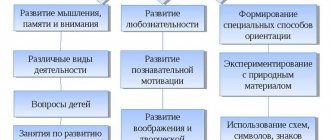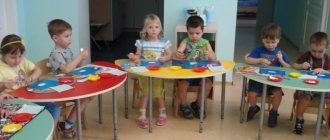MAGAZINE Preschooler.RF
Multi-level didactic games and exercises in visual artsPrepared by: teacher of MBDOU No. 152 Rogova S. A. Orenburg 2021
Konstantin Balmont wrote:
Perhaps all of nature is a mosaic of flowers? Perhaps all nature is different voices? Perhaps all nature is just numbers and features? Perhaps all nature desires beauty?
These words were written more than a century ago and the task of the teacher is to help this charm, the beauty of nature, but for this, according to Saloukhin, “You must wait until beauty itself invites you to be an interlocutor, and not slide through it fussy, hasty glance.
Teachers know that children show increased interest in the visual arts, and the main task is to raise an active, creative child.
And one of the main tasks is to maintain spontaneity, sincerity, and the desire for creativity; children are characterized by an active attitude to the events depicted, some even voice the events depicted.
An important point in the learning process is familiarization with national characteristics in art, with the decorative and applied creativity of the peoples of Russia, as well as an idea of the talent of each person of the nation.
Each nation passes on to new generations its vision of beauty, housing, dishes, and clothing. This is not only the development of creative abilities, but also the development of interest in culture as a whole. To solve these problems, the main goals can be identified:
- Motivational activity: when the child conveys his impression of the ability to build a composition and develop it, choose a color scheme.
- Comparison is the main way to activate thinking and fully reveal its individuality, through qualities that must be taken into account, others must be educated, and others must be developed in the process of creative activity.
- Game activity: here you can recall the words of Sukhomlinsky “like a child without a game, without a fairy tale”
- research activity: gone are the days when children painted only with gouache and watercolor
Not least important, consolidating skills and developing creative abilities is the creation of a developmental environment. In accordance with the Federal State Educational Standard
We know that children’s first drawings are made up of scribbles, geometric figures, lines not connected with each other, by the age of three they comprehend their scribbles and begin to consider them as an image of things and the child’s capabilities begin to grow, like a growing cloud, and our task is to help the development of these abilities.
Our main task is to enrich the experience of artistic and productive activity at all levels, to promote the development of artistic technologies based on the integration of intellectual activity and the development of manual skills.
In accordance with the Federal State Educational Standard, when working with children, the individual abilities of each child, their interests and preferences are taken into account. A prerequisite for exploring artistic creativity is the ability to see color. First, I invite the children to look at the rainbow and read the poems:
“The rooster saw a rainbow, what a beautiful tail
The ram saw a rainbow, what a high bridge
And the horse looks at the rainbow, the horseshoe is large
The river looks like a rainbow and there is a river in the sky"
I offer the children stripes and make a rainbow out of them; if the children find it difficult (with a low or average level of development), I invite them to choose the colors of the rainbow, then a large drawing of a rainbow is placed in the ecological corner and I invite the group to find the colors of the rainbow on the street. Children with a high level of development can be offered cold shades for “Snowman” , and warm colors for “Sunshine” , and as a conclusion, you can offer “Rainbow Dance” with ribbons of the corresponding color.
The next stage of getting to know the shades is the game “Round Dance of Colors” .
“I’ll take three basic colors, these colors are not simple, all the rest are made up of them, if red and yellow make friends, what new paint will come out, bring your girlfriend here, if yellow and blue make friends, what new paint will come out, bring your girlfriend here, if red and blue If you make friends, what new paint will come out, bring your girlfriend"
For children with a high level of development, you can introduce the following complication, introduce the game “Seasons” . Where children create a three-dimensional picture of autumn and this helps to understand the volume of the picture in the future, when they draw a landscape, they will draw not only in the foreground, but use the entire space of the sheet.
For children with a low level of development, you can offer the game “Autumn Palette” . Where they can choose appropriate fall colors.
Children's acquaintance with folk art begins with preliminary work, when children examine the elements of paintings and get acquainted with the products of folk craftsmen, mastering the color palette.
Children with a low and average level of development can be asked to first select elements of a painting, for example, Dymkovo, then decorate a young lady or a lamb, and children with a high level of development can be asked to sculpt from clay and then paint them.
Acquaintance with Gzhel painting begins with the introduction of simple elements: a grid and a cage with dots. You can invite a child who finds it difficult to move his finger on a sheet of paper from top to bottom from right to left, and children with a high level of development can decorate the dishes with elements of painting, and subsequently paint the sculpted products. Also, continuing to introduce folk art, you can offer the game “Funny Horse” , matching the horse with the selected painting, this is mainly used for children of low and intermediate level.
To consolidate your cutting and sculpting skills, you can start with finger games. Children timidly separate pieces of clay and plasticine, and begin to process them, and very quickly these pieces, with the help of rolling, rolling out, begin to take shape, and they happily string their beads or cakes onto wire or thread.
Finger games are a very important part of developing fine motor skills. These games are very emotional, exciting, they contribute to the development of speech and creative activity, thereby developing dexterity, the ability to control one’s movements, and the ability to concentrate attention on one type of activity.
Four-year-old children can only use their fingers, but children of older preschool age can be offered: balls, cubes.
Finger game “My Family”
This finger is grandpa, This finger is grandma, This finger is daddy, This finger is mommy,
This finger is me, that’s my whole family.
Children alternately bend their fingers one at a time, and when finished, twist their fist.
Finger game "Hide and Seek"
Fingers played hide and seek and removed their heads
This is how the heads were removed.
Children rhythmically bend and straighten their fingers, first on one hand and then on the other. Older children can be asked to put animal figures on their fingers. Finger games can also be used in cutting skills, for example, first ask to name all the geometric shapes in the picture, and then fold them in different directions, then cut them along the fold lines. From the resulting figures, offer to lay out a rug, classify them by color and shape.
For children with an average level of development, you can offer the game “Find the right color” . Children must trace the outline of the proposed fruit or vegetable with their finger and find the corresponding color. And for children with a high level of development, the game “Assemble a Vase” , which later helps children to better navigate, cutting out exactly the same objects with scissors.
In each group there are children with advanced development, which is also provided for by the developmental environment created in the group, this can be eco-plastics, the use of improvised and waste materials, you can offer children pictures from pencil shavings, the children draw the outline of trees with a house, and then their imagination begins to work. Eggshells, leaves, a collection of stones can serve as a unique process of getting used to the world of creativity. Our work involves the full disclosure of the child’s individual qualities, some of which must be taken into account, others must be nurtured, and others must be developed.
| Next > |
Progress of the game:
Children stand in a circle. An adult shows one of the colored circles, for example, red, puts it in the center and asks them to tell what this color is. The child to whom the adult rolls the ball answers. Possible answers for children : tomato, flower, holiday flag, etc. Answers should not be repeated. Then the children are shown a circle of a different color, and the game continues.
"Complete the picture "
Target:. Develop a child's attention and visual perception
Material. Paper; pencils






